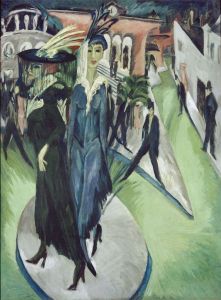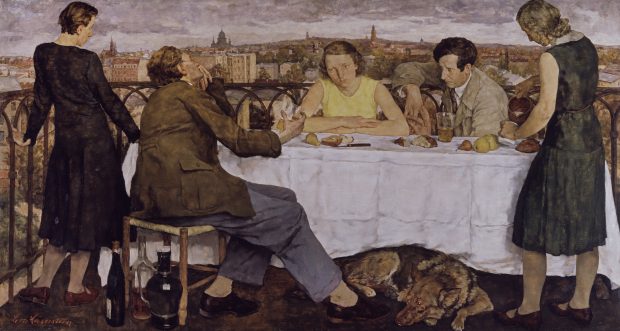From the September 2021 issue of Apollo.
Berlin is perpetually rebuilding itself – toss a brick in any direction and you’ll probably hit roadworks or a construction site – and some architectural projects, such as the notoriously over-budget Brandenburg Airport and the controversial, traditionalist rebuilding of the Berlin Palace, drag on for decades. Yet in the last year, somehow, both of those behemoths finally opened. And, in August, so did a more beloved edifice: the low-slung glass box, up the road from Potsdamer Platz, that is Mies van der Rohe’s Neue Nationalgalerie, which has been closed for renovation since 2015.
Actually, ‘restoration’ is a better word. You don’t mess with Mies, or at least that’s the view that overseers David Chipperfield Architects have taken. Many of the changes to the building, which was completed in 1968 and was the modernist master’s final project, are all but invisible despite the €140 million that has been spent; this is a good thing. Chipperfield’s technicians have removed more than 35,000 architectural components, cleaned them up and put them back in place. They’ve renewed the worn carpets in the white-cube galleries downstairs and dealt with degraded concrete, climate-control systems and 580 tonnes of contaminants, as well as bedevilling structural issues that have led to those big glass curtain-walls cracking for decades. They’ve converted vintage lighting to LEDs, fashioned a ticket counter in Miesian style, and commissioned Knoll International to make new Barcelona chairs while preserving the design-classic originals. The sculpture garden, which became an entropic mix of cracked concrete and weeds many years ago, has been reopened. In many ways, the building looks as it always did, except that now it’s not disintegrating in slow motion.
Potsdamer Platz (1914), Ernst Ludwig Kirchner. Photo: © Nationalgalerie – Staatliche Museen zu Berlin/Jörg P. Anders

That said, there are updates, both in physical terms and, in terms of programming, conceptual ones. There’s a proper cloakroom and – of course! – a shop, and improved accessibility via ramps and lifts. And there are curatorial responses to changing times that can be seen in the opening exhibitions. In the main space upstairs is a suave Alexander Calder retrospective, ‘Minimal/Maximal’ (until 13 February 2022). This, true to its title, oscillates between huge confections of intersecting, curving steel planes such as Têtes et queue (1965), which feels like a horse crossed with a crown, and tiny, toy-like maquettes like Louisa’s 43rd Birthday Present (1948) – whose contents fit inside a cigarette box – as well as the American artist’s signature mobiles. These, and the smaller works, are being ‘activated’ at regular intervals by invigilators, a nod to the current presentational fashion for interaction; there are also replicas of a Calder-designed chess set (from 1944) that visitors are invited to play on. Calder and Mies apparently never met but they go together beautifully, sharing interests in lightness, openness and movement.
Long-standing watchers of the Museum Island scene – five museums, of which the Neue is devoted to 20th-century art – will not be surprised to find this place reopening with a grand display by a male artist. The curators, though, are quick to point out that Barbara Kruger is up next, that there’s a Monica Bonvicini show planned and dance performances scheduled by Anne Teresa de Keersmaeker. (There will also, we’re told, be projects addressing the hard-to-heat institution’s own apparent eco-unfriendliness.) Included in the reopening, meanwhile, is an impressive show downstairs by Rosa Barba, a whirring array of film projectors mixing filmic abstractions, documentary-ish ventures into bunkers, and an intermittent recording of a drum solo via which all the films are synced and triggered (until 16 January 2022). And the current hang of works from the testosterone-heavy Nationalgalerie collection, ‘The Art of Society: 1900–45’, suggests that, while the museum’s doors may have been closed for the last six years, the curators’ eyes haven’t been.
Evening over Potsdam (1930), Lotte Laserstein. Staatliche Museen zu Berlin, Nationalgalerie. VG Bild-Kunst, Bonn 2019

The first work you see, at the entrance to the show, is Lotte Laserstein’s pellucid group portrait Abend über Potsdam (Evening over Potsdam, 1930), and once inside the light-filled, open plan space – Mies didn’t want to direct viewers but to give them autonomy – the sections alternate between simply showing off the collection’s jewels and nodding to issues. There’s a group of paintings by German artists done in foreign climes which is alert to the problematics of exoticisation; reliefs by Hans Arp are countered by Hilma af Klint drawings that give the lie to abstraction being a man’s world, a man’s creation. There’s a satisfyingly geeky room offering a deep dive into the work of the Blue Rider artists (the exhibition catalogue, meanwhile, looks into who their female models were), as well as a segment on artists working in exile.
All of this, meanwhile, had to be achieved under constraints; the institution has a tiny budget for acquisitions and has relied on the largesse of collectors, but collectors are increasingly quitting Berlin. The existing collection is clearly capacious enough to tell new and different stories, though, and assumedly that will continue. For any number of years, I’ve tended to call the Berlin institutional scene sleepy, lacking in dynamism – and I probably started doing that when the Neue Nationalgalerie closed. It’s good to have it back; and for those who’d gotten used to seeing this place as that classically Berlin vista, an unlovely building site, fear ye not. Right next door is a vast muddy area, the beginnings of work on the Neue Nationalgalerie’s sister site, the Herzog & De Meuron-designed Museum of the 20th Century. It won’t be finished for years.
From the September 2021 issue of Apollo.


